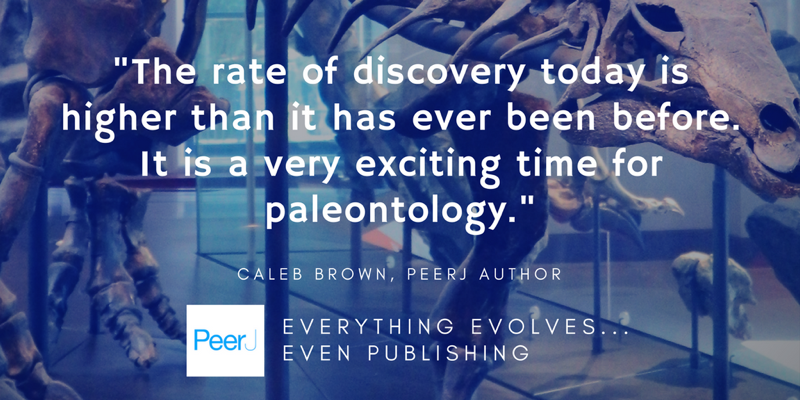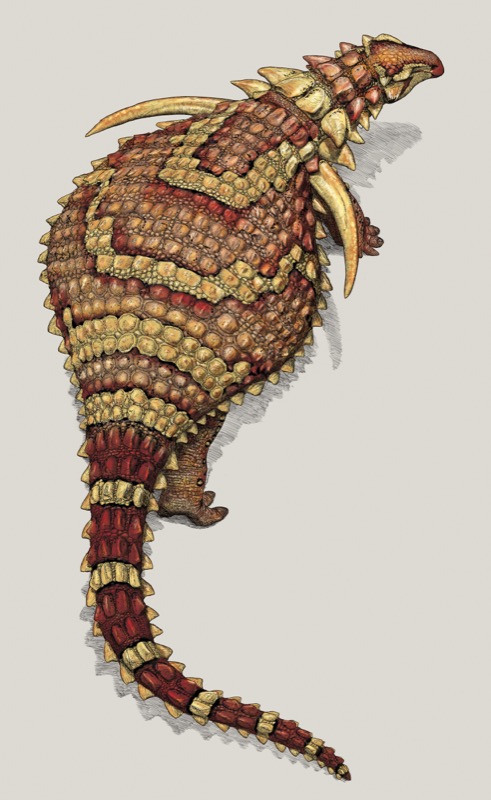Yesterday we published an exciting paleontology paper by Caleb Brown titled ‘An exceptionally preserved armored dinosaur reveals the morphology and allometry of osteoderms and their horny epidermal coverings‘.
This ‘one-in-a-billion’ nodosaur specimen is currently on public display at the Royal Tyrrell Museum of Palaeontology, in Drumheller, Alberta. Here we talk to author Caleb Brown about this unique specimen, its horn-like covering, and the reasons why it is a great time to be a paleontologist today.
 Can you tell us a bit about yourself?
Can you tell us a bit about yourself?
I am the Betsy Nicholls Post-Doctoral Fellow at the Royal Tyrrell Museum of Palaeontology in Drumheller, Alberta, Canada. My research largely focuses on ornithischian dinosaurs and their diversity, growth, evolution, and ecology. Of particular interest are the elaborate bony ornamentations seen on many species, such as the horns and frills of ceratopsian (horned dinosaurs) and the crests of hadrosaurs (duck-billed dinosaurs). These are some of our best understood dinosaurs, and their impressive fossil record allows for testing ideas about how these structures evolved, grew, and functioned.
My research includes active fieldwork in the Province of Alberta, where a rich dinosaur fossil record from the Cretaceous is preserved. This region represents an unparalleled window into the ancient world, and this ongoing field research adds both to the Museum’s collection and to our knowledge of these iconic animals.
Can you briefly explain the research you published in PeerJ?
This research focuses on documenting the armour of an exceptionally preserved new armoured dinosaur from Alberta, recently named Borealopelta markmitchelli. The animal is a nodosaur – similar to the related, and more well-known, ankylosaur but without the tail club and with large spines on the shoulder. This specimen is unique because it preserves both exquisite detail in the animal’s skin and horn-like tissues, while also maintaining the animals original three-dimensional form. The result is a truly impressive fossil, and one of the best-preserved dinosaurs ever found. I joke that you don’t even need your imagination to figure out what the animal looked like; it is all preserved for you to see.

Photograph showing the armoured dinosaur Borealopelta markmitchelli (Royal Tyrrell Museum of Palaeontology 2011.033.0001) in oblique view. Image courtesy of the Royal Tyrrell Museum of Palaeontology, Drumheller, Alberta.
Although seeing the specimen in person cannot be substituted, National Geographic produced an interactive digital 3D model, that can give you a great sense of the specimen. When alive, the animal would have been a slow and lumbering, covered head to tail in bony armour spending its life munching on low-growing Cretaceous plants.
The current research paper delves deep into the details of the shape and size of the armour, bony plates (called osteoderms) embedded in the skin and covered in a horn-like (keratinous) tissue. By measuring the length, width, and height of each osteoderm, the shape and size of these bony plates was able to be documented, as were changes along the body, from the neck to the back to the base of the tail. The osteoderms on the neck are large with tall keel, and they get smaller and flatter onto the back and hip regions. Of particular interest is the large spine located above each shoulder, which sticks out to the side and is more than half a metre long.
Because the specimen was so well-preserved it was also possible to document the thickness of the horn-like coverings that cap the osteoderms. These are almost never preserved on other dinosaur specimens, and this marks the first time we can actually measure them. The horn-like coverings of the armour across the back and hips is thin and flat. For the large, keeled osteoderms along the neck a horn keel caps and exaggerates the bony keel. Most impressive is the shoulder spine, where the projecting horn tissue makes up around one-quarter if the entire length of this spine – increasing the length of the spine by about 133%.

Dorsal (bird’s eye) view of the armoured dinosaur Borealopelta markmitchelli (Royal Tyrrell Museum of Palaeontology 2011.033.0001) as a composite photograph (A), drawing showing preserved tissues (B), and reconstructed portions with compact car for scale (C). Image courtesy of the Royal Tyrrell Museum of Palaeontology, Drumheller, Alberta.
This pattern is surprisingly similar to that seen in living animals with horns, like bison and chameleons. In these animals, the horns are primarily used to intimidate or fight with rivals, or attract mates, not to defend from predators. This may suggest that although many of the osteoderms in the nodosaur may have evolved to defend the animal from predation, the extreme exaggerating of the shoulder spine may better be explained by sexual-selection.
What kinds of lessons do you hope your readers take away from the research?
The major take home messages I hope readers go away with are as follows:
- We are increasingly finding soft tissues of dinosaurs preserved along with the skeleton. Gone are the days when dinosaurs were only known from bones, and we now have things like skin, feathers, claws sheaths, pigments, and horn sheaths. This should be very exciting to future paleontologist and the public in general.
- We finally have an idea what the horn-like or keratinous covering are like in armoured dinosaurs (or at least in this one armoured dinosaur). This does not just have implications for armoured dinosaurs, but also for other dinosaur with elaborate bony projections, like horned dinosaurs, and dome-headed dinosaurs.
- Finally, it is worth considering that the elaborate spines of nodosaurs may be display structures. This is not a new idea, as it has been suggested by many authors, but it seems to have found stronger support among the horned-dinosaurs, duck-billed dinosaurs, and dome-headed dinosaurs, than amongst the armoured dinosaurs.
What is your favorite part of your job as a paleontologist?
This is likely a common answer by a paleontologist, but the aspect of the job that I like the most is the chance to discover something new. This could be physically discovering a new fossil, species, or occurrence in the field, or making exciting discoveries back in the lab. There is often a public perception that we have learned everything we can about the ancient past – this could not be further from the truth. The rate of discovery today is higher than it has ever been before. It is a very exciting time for paleontology.
What drew you to publish with PeerJ?
I am a fan of the novel publication model of PeerJ. I am a proponent of Open Access (making scientific research available to all, without subscription payments) so I try to seek out that option when it comes to publishing all of my research. PeerJ is one of the most efficient and cost-effective means of publishing Open Access. My previous interactions with PeerJ, both as author and reviewer, have been positive, so it was a natural choice.
How was your publishing experience with us?
The publication experience with PeerJ has largely been positive. The submission process is smooth, and the reviews were prompt (the reviewers also deserve credit in this regard).
Would you submit again, and would you recommend that your colleagues submit?
Yes, I already have submitted again (actions speak louder than words). I would encourage my research colleagues that are looking for an efficient, cost-effective way to publish their research Open Access to check out PeerJ as an option.
Anything else you would like to add?
One thing to add is a little bit of shameless self-promotion…Specifically I would like to highlight that the specimen that is the subject of this research is currently on public display at the Royal Tyrrell Museum of Palaeontology, in Drumheller, Alberta. It really is a ‘one-in-a-billion’ specimen, and is the closest you will likely ever come to coming face to face with a dinosaur in the flesh (excluding birds of course). You should come check it out.
Thanks for sharing your thoughts, Caleb! Read the full paper here.





